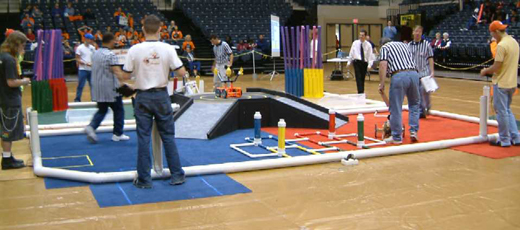Warp X
(Compliments of SA BEST)
Believe it or not, this is the 10th BEST game. In commemoration of the past nine games, this game includes elements from all the previous games. The table below summarizes the source of these elements. For those of you that are BEST aficionados, you’ll notice that some of the elements have been slightly modified for this year’s game.
Year |
Game |
Game Element(s) |
1993 |
PVC Insanity |
PVC Rings, Pegs and Candles |
1994 |
Bumble Rumble |
Bumble Balls |
1995 |
Totally AweSUM |
Noodles |
1996 |
Block-n-Load |
PVC Grid |
1997 |
Dynamite Duel |
Dynamite Sticks |
1998 |
Toxic Troubles |
Containment Bins |
1999 |
Rocket Race: The Alien Escape |
Alien Escape Pods (tennis balls) |
2000 |
Pandemonium in the Smithsonian |
Paddle Switch |
2001 |
Rad to the Core |
Multi-Tube Containment Vessels (MTCV) |
The objective of this game is to design and build a remotely controlled device that recovers game pieces from previous BEST games.
The playing field is rectangular, 24 feet wide by 26 feet long, with an elevated, 6-foot diameter, rotating platform in the center of the field. All game pieces start on the spotters’ side of the field, while the machines start on the drivers’ side of the field. The two sides of the field are separated by the rotating black hole over which machines must cross to get to the game pieces. Game pieces and machines cannot travel from one side of the field to the other side of the field without crossing over the rotating platform. Note the hatched “Out of Bounds” area in the drawing. Four teams play at a time in each 3-minute long match.
Four Multi-Tube Containment Vessels (MTCVs), color-coded to match each team’s starting position, are located on the back edge of the field near the spotters. Each MTCV consists of twelve tubes. Points scored at the MTCVs are awarded to the team playing in the corresponding color position. The tallest row (5 tubes) of the MTCV starts with a noodle in each tube; removing a noodle scores 10 points. The lower two rows (7 tubes total) score 10 points for each tube containing either a dynamite stick or an alien escape pod (tennis ball). Multiple objects in a tube do not score additional points. The dynamite sticks and alien escape pods are held in the plastic containment bin at the start of each match.
Four Bumble Balls roam the spotters’ side of the field at the start of the match. A team can score 50 points by retrieving a Bumble Ball and placing it within their color-matched grid on the drivers’ side of the field. The majority of the Bumble Ball must be within the grid to score.
Initially, 4-inch PVC rings are placed on wooden pegs that surround the platform. To score points with the rings, a team must place one or more rings on their color-matched candle. The first ring scores 20 points, the second ring scores 30 points and the third ring scores 40 points (i.e. 90 points total are available for placing all three rings on the candle.)
The paddles serve two purposes: 10 points are earned for switching the paddle, and scoring ties are resolved by the order in which the paddles are switched.
Game pieces and paddles only score if they are in their scoring position at the end of the match.

There are two phases to the contest, a partial round robin preliminary competition and a six game round robin playoff between the top eight teams. During the preliminary competition each team plays eight games against randomly selected opponents. The team’s average score over the preliminary competition is used to rank the team and to determine which eight teams advance to the final round robin playoff. When computing a team’s average score for the preliminary competition, the team’s low score is dropped.
For the final round robin playoff, the top eight teams each play 3 matches. The teams’ total scores for these three matches determine the final ranking order. Ties are resolved in the same manner as for the seeding competition.

 Announcements
Announcements










